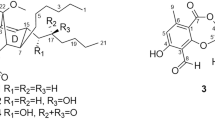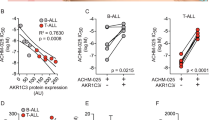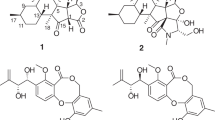Abstract
In our screening program on marine-derived actinomycetes, Nonomuraea sp. AKA32 isolated from deep-sea water collected from a depth of 800 m in Sagami Bay, Japan was found to produce compounds cytotoxic to cancer cells. Activity-guided purification led to the isolation of a new aromatic polyketide, akazamicin (1), along with two known compounds, actinofuranone C (2) and N-formylanthranilic acid (3). Structures of these compounds were elucidated through the interpretation of NMR and MS spectroscopic data. Compounds 1, 2, and 3 displayed cytotoxicity against murine B16 melanoma cell line with the IC50 value of 1.7, 1.2, and 25 μM, respectively.
Similar content being viewed by others
Log in or create a free account to read this content
Gain free access to this article, as well as selected content from this journal and more on nature.com
or
References
Berdy J. Bioactive microbial metabolites. J Antibiot. 2005;58:1–26.
Rudi P, Ingrid S, Mayra M. Antibiotics produced by Streptomyces. Braz J Infect Dis. 2002;16:466–71.
Tiwari K, Gupta RK. Rare actinomycetes: a potential storehouse for novel antibiotics. Biotechnol. 2012;32:108–32.
Paolo M, Marianna I, Sonia M, Margherita S, Stefano D. Discovering new bioactive molecules from microbial sources. Microb Biotechnol. 2014;7:209–20.
Monisha K, Renu S, Rup L. Seletive isolation of rare actinomycetes producing novel antimicrobial compoumds. IJABR. 2011;2:357–75.
Ameriga L, Linda C, Giogio T, Flavia M. Rare genera of actinomycete as potential producers for new actinomycetes. Antonie Van Leeuwenhoek. 2000;78:399–405.
Baltz RH. Antibiotic discovery from actinomycetes: will a renaissance follow the decline and fall? SIM News. 2005;55:186–96.
Fenical W, Jensen PR. Developing a new resource for drug discovery: marine actinomycete bacteria. Nat Chem Biol. 2006;2:666–73.
Xiong ZQ, Wang JF, Hao YY, Wang Y. Recent advances in the discovery and development of marine microbial natural products. Mar Drugs. 2013;11:700–17.
Yiwen H, Jiahui C, Guping H, Jianchen Y, Xun Z, Yongcheng L, et al. Statistical research on the bioactivity of new marine natural products discovered during the 28 years from 1985 to 2012. Mar Drugs. 2015;13:202–21.
Imada C. Treasure hunting for useful microorganisms in the marine environment. In: Kim SK editor. Marine microbiology: bioactive compounds and biotechnological applications. Wiley-VCH, Weinheim, 2013:21–31.
Furumai T, Takagi K, Igarashi Y, Saito N, Oki. T. Arisostatins A and B, new members of tetrocarcin class of antibiotics from Micromonospora sp. TP-A0316. I. Taxonomy, fermentation, isolation and biological properties. J Antibiot. 2000;53:227–32.
Igarashi Y, Takagi K, Kan Y, Fujii K, Harada K, Furumai T, et al. Arisostatins A and B, new members of tetrocarcin class of antibiotics from Micromonospora sp. TP-A0316. II. Structure determination. J Antibiot. 2000;53:233–40.
Furumai T, Igarashi Y, Higuchi H, Saito N, Oki T. Kosinostatin, a quinocycline antibiotic with antitumor activity from Micromonospora sp. TP-A0468. J Antibiot. 2002;55:128–33.
Igarashi Y, Higuchi H, Oki T, Furumai T. NMR analysis of quinocycline antibiotics: structure determination of kosinostatin, an antitumor substance from Micromonospora sp. TP-A0468. J Antibiot. 2002;55:134–40.
Sasaki T, Igarshi Y, Saito N, Furumai T. Watasemycins A and B, new antibiotics produced by Streptomyces sp. TP-A0597. J Antibiot. 2002;55:249–55.
Furumai T, Eto K, Sasaki T, Onaka H, Saito N, Igarashi Y. TPU-0037-A, B, C and D, novel lydicamycin congeners with anti-MRSA activity from Streptomyces platensis TP-A0598. J Antibiot. 2002;55:873–80.
Igarashi Y, Miyanaga S, Onaka H, Takeshita M, Furumai T. Revision of the structure assigned to the antibiotic BU-4664L from. Micro J Antibiot. 2005;58:350–2.
Igarashi Y, Ikeda M, Miyanaga S, Kasai H, Shizuru Y, Matsuura N, et al. Two butenolides with PPARα agonistic activity from a marine-derived Streptomyces. J Antibiot. 2015;68:345–7.
Harunari E, Komaki H, Igarashi Y. Biosynthetic origin of butyrolactol A, an antifungal polyketide produced by a marine-derived. Streptomyces Beilstein J Org Chem. 2017;13:441–50.
Terahara T, Yamada K, Nakajima J, Igarashi Y, Kobayashi T, Imada C, et al. Bacterial community structures of deep-sea water investigated by molecular biological techniques. Gene. 2016;576:696–700.
Heinisch L, Roemer E, Jutten P, Haas W, Werner W and Mollmann U et al. Semisynthetic derivatives of madurahydroxylactone and their antibacterial activities. J Antibiot. 1999;52:1029–41.
Kim BM, Choi HY, Kim GW, Zheng CJ, Kim YH, Kim WG, et al. Madurahydroxylactone, an inhibitor of Staphylococcus aureus FtsZ from Nonomuraea sp. AN100570 J Microbiol Biotechnol. 2017;27:994–1998.
Um SH, Bang HS, Shin JH, Oh DC. Polyketide from beetle associated actinomycete. Nat Prod Sci. 2013;19:71–75.
Tomita K, Nishio M, Saito K, Yamamoto H, Hoshino Y, Ohkuma H, et al. Pradimicins A, B and C: new antifungal antibiotics. I. Taxonomy, production, isolation and physico-chemical properties. J Antibiot. 1990;43:755–62.
Ogasawra Y, Benjamin JY, Greenberg JA, Rogeli S and MElancon CE Expanding our understanding of sequence-function relationships of type II polyketide biosynthetic gene clusters: bioinformatics-guided identification of Frankiamicin A from Frankia sp. EAN1pec. PLos ONE. 2015; https://doi.org/10.1371/journal.pone.0121505.
Strauss DG, Baum M, Fleck WF. Butylmaduramycin, a new antibiotic from Actinomadura rubra. J Basic Microbiol. 1986;26:169–72.
Cho JY, Kwon HC, Williams PG, Kauffman CA, Jensen PR, Fenical W, et al. Actinofuranones A and B, polyketides from a marine-derived bacterium related to the genus. Streptomyces J Nat Prod. 2006;69:425–8.
Saitou N, Nei M. The neighbor-joining method: a new method for reconstructing phylogenetic trees. Mol Biol Evol. 1987;24:189–204.
Acknowledgements
We are appreciating to the Rotary Yoneyama Memorial Foundation scholarship for supporting this study.
Author information
Authors and Affiliations
Corresponding author
Ethics declarations
Conflict of interest
The authors declare that they have no conflict of interest.
Additional information
Publisher’s note: Springer Nature remains neutral with regard to jurisdictional claims in published maps and institutional affiliations.
Supplementary information
Rights and permissions
About this article
Cite this article
Yang, T., Yamada, K., Zhou, T. et al. Akazamicin, a cytotoxic aromatic polyketide from marine-derived Nonomuraea sp. J Antibiot 72, 202–209 (2019). https://doi.org/10.1038/s41429-018-0139-7
Received:
Revised:
Accepted:
Published:
Issue date:
DOI: https://doi.org/10.1038/s41429-018-0139-7
This article is cited by
-
Development of a drug discovery approach from microbes with a special focus on isolation sources and taxonomy
The Journal of Antibiotics (2023)
-
Rausuquinone, a non-glycosylated pluramycin-class antibiotic from Rhodococcus
The Journal of Antibiotics (2022)
-
Comprehensive genome analysis of a novel actinobacterium with high potential for biotechnological applications, Nonomuraea aridisoli sp. nov., isolated from desert soil
Antonie van Leeuwenhoek (2021)



